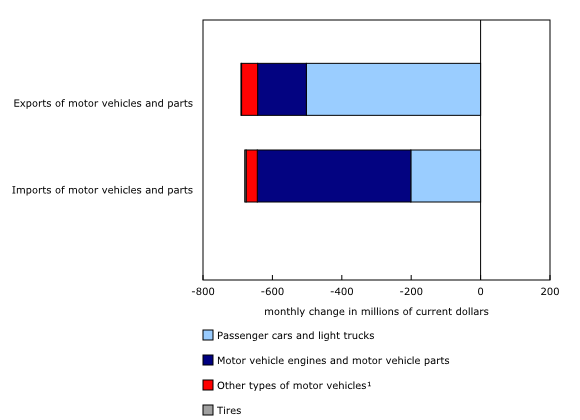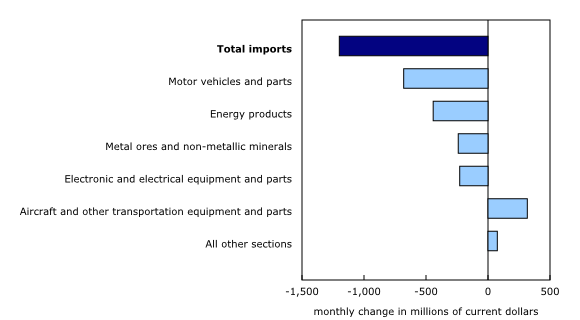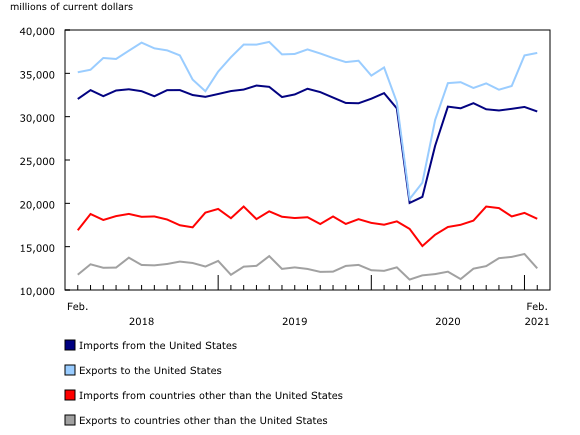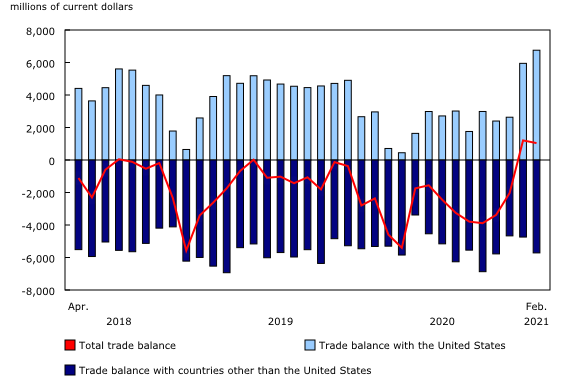Canadian international merchandise trade, February 2021
Archived Content
Information identified as archived is provided for reference, research or recordkeeping purposes. It is not subject to the Government of Canada Web Standards and has not been altered or updated since it was archived. Please "contact us" to request a format other than those available.
Released: 2021-04-07
In February, Canada's merchandise exports decreased by 2.7%, while imports fell 2.4%. As a result, Canada's merchandise trade surplus with the world narrowed from $1.2 billion in January to $1.0 billion in February. This was the first time since late 2016 that the trade balance was in a surplus position for two consecutive months.
To explore the most recent results of Canada's international merchandise trade in an interactive format, see the International merchandise trade monthly interactive dashboard.
Global shortage of semiconductor chips impacts trade in motor vehicles and parts
Recently, the supply of semiconductor chips—used in the manufacture of several products, including motor vehicles—began to fall short of worldwide demand. Many auto assembly plants in North America had to reduce or stop production, and this had a significant impact on Canadian exports and imports of motor vehicles and parts in February. As explained in the most recent release of the Monthly Survey of Manufacturing, the shortage of semiconductor chips is expected to further reduce vehicle production in the months ahead. This situation could also be exacerbated by the recent blockage of the Suez Canal.
Exports of motor vehicles and parts decreased by 10.2% to $6.1 billion, the second-largest decrease in the exported product sections in February. Exports of passenger cars and light trucks decreased by 11.5% as many assembly plants in Canada were forced to slow production because of the lack of semiconductor components. Exports of engines and parts (-7.9%) were also down significantly in February.
Imports of motor vehicles and parts fell 7.8% to $8.0 billion, the largest decrease among import product sections in February. Imports of engines and parts (-14.4%), which frequently include semiconductor chips as inputs, posted the largest decline. Imports of passenger cars and light trucks (-4.6%) were also down significantly, with worldwide production adjusting to this new challenge.
Total exports decrease after a strong increase in January
After a surge of 8.2% in January, total exports decreased by 2.7% to $49.9 billion in February, a level 4.1% higher than that set in February 2020. The largest declines were observed in the metal and non-metallic mineral products, motor vehicles and parts, and aircraft and other transportation equipment and parts product sections. Non-energy exports declined by 6.5%. In real (or volume) terms, total exports were down 3.8%.
Exports of metal and non-metallic mineral products (-10.9%) contributed the most to the decline in total exports in February. Exports of unwrought gold, silver and platinum group metals and their alloys—a category mainly composed of gold—decreased by 22.4% to $1.9 billion, their lowest level since September 2019. Fewer asset transfers within the banking sector and lower sales of refined gold were the cause of the decline in February.
Exports of aircraft and other transportation equipment and parts fell 20.3% in February, mainly as a result of lower exports of aircraft (-30.2%). In January, a Canadian airline retired a large number of aircraft from its fleet and shipped the used airplanes to the United States, resulting in a large gain in exports of aircraft. Although exports of this type continued in February, a smaller number of used aircraft were shipped to the United States.
Exports of metal ores and non-metallic minerals decreased by 26.7% in February, mainly because of lower exports of iron ores (-39.8%). Despite the COVID-19 pandemic, exports of iron ores rose 16.8% in 2020 and then reached a record in January 2021, mainly because of higher global demand for these products. Notwithstanding the monthly decrease, demand remained strong for these commodities.
Exports of energy products partially offset the overall decrease, up 18.3% to $9.5 billion, their highest level since December 2019. Exports of natural gas, which more than doubled in February, contributed the most to the growth. This increase was mainly attributable to higher prices, as extreme weather in the southern United States and power outages in Texas in February led to unusually high volatility in natural gas prices. Exports of natural gas are estimated in the current month, and large variations in prices can result in more significant revisions once this estimate is replaced with actual data in the following month. Exports of crude oil and crude bitumen (+6.8%) also increased in February, mainly because of higher prices. This was the fifth consecutive monthly increase in exports of crude oil.
Total imports decrease for a third time in the last four months
Total imports decreased by 2.4% in February to $48.8 billion, their lowest level since August 2020. Imports of motor vehicles and parts had the largest decline, followed by energy products. In real (or volume) terms, total imports were down 3.5%.
After a 22.8% increase in January, imports of energy products decreased by 21.4% in February. As in the previous month, imports of refined petroleum products (-58.0%) contributed the most to the monthly movement. Imports of diesel fuels and motor gasoline decreased the most in February.
Higher imports of aircraft and other transportation equipment and parts (+29.1%) partially offset the overall decline in February. Following two months of imports below the $100 million mark, imports of aircraft (+$453 million) increased in February because of the import of four commercial airliners. This was the first time since August 2019 that at least four commercial airliners were imported.
Trade with non-US countries decreases, while the trade surplus with the United States grows again
Following five months of growth, exports to countries other than the United States decreased by 11.7% in February to $12.5 billion. There were lower exports to the United Kingdom (gold), Saudi Arabia (other transportation equipment) and the Netherlands (iron ores and oilseeds).
Imports from countries other than the United States fell 3.6% in February. Imports from Mexico (various products), Switzerland (metal products and pharmaceutical products) and Germany (various products) posted the largest decreases.
Canada's trade deficit with countries other than the United States widened from $4.7 billion in January to $5.7 billion in February.
After a 10.5% rise in January, exports to the United States increased by 0.8% in February to $37.4 billion. Large declines in exports of motor vehicles and parts were more than offset by the strong increases in exports of natural gas and crude oil, which were mainly driven by higher prices.
Imports from the United States were down 1.7% to $30.6 billion, mostly because of the decrease in imports of motor vehicles and parts. Canada's trade surplus with the United States widened from $5.9 billion in January to $6.8 billion in February. This was the largest surplus since September 2008.
When the average exchange rates of January and February are compared, the Canadian dollar gained 0.15 US cents relative to the American dollar.
Revisions to January merchandise export and import data
Imports in January, originally reported as $49.8 billion in the previous release, were revised to $50.0 billion in the release for the current reference month. Exports in January, originally reported at $51.2 billion in the previous release, were essentially unchanged in the current month's release.
Trade in medical and protective goods and vaccines
Imports of medical and protective goods were down 1.6% to $2.6 billion in February on a customs basis, the third consecutive monthly decrease. Imports of personal protective equipment (-17.6%) were lower, as imports of other protective equipment and face and eye protection continued to gradually return to levels seen before the COVID-19 pandemic. Imports of gloves have declined each month since reaching a peak in November; however, they remained well above pre-pandemic levels. In February, imports of medical equipment and products (-5.1%) and disinfectant and sterilization products (-8.9%) also fell, with diagnostic products (+27.4%) partly offsetting the declines. Year-over-year imports of medical and protective goods were 21.3% higher in February. Meanwhile, following three consecutive monthly decreases, exports of medical and protective goods rose 9.8% to $1.4 billion in February. Despite this monthly increase, exports were 3.9% lower year over year.
Imports of "vaccines for human medicine other than for influenza," the category that includes the COVID-19 vaccines, rose 89.3% to a record $106.6 million in February. Large month-over-month movements are common for this category, with significant increases expected at this time of year. Still, imports were 41.1% higher compared with the same month last year. For February, it is estimated that the total value of Canada's imports of COVID-19 vaccines was approximately $47 million, double the estimated value in January. Import values for COVID-19 vaccines are preliminary and are subject to revision. Given that the reporting basis of these data may be different than other publicly available sources of information, caution should be exercised when inferring information based on combining these sources.
Monthly trade in services
In February, monthly service exports were down 1.6% to $9.1 billion. Service imports decreased by 4.9% to $9.1 billion.
When international trade in goods and international trade in services were combined, exports decreased by 2.5% to $59.0 billion in February, while imports fell 2.8% to $57.9 billion. As a result, Canada's trade surplus with the world for goods and services combined was $1.1 billion in February.
Note to readers
Merchandise trade is one component of Canada's international balance of payments (BOP), which also includes trade in services, investment income, current transfers, and capital and financial flows.
International trade data by commodity are available on both a BOP and a customs basis. International trade data by country are available on a customs basis for all countries and on a BOP basis for Canada's 27 principal trading partners (PTPs). The list of PTPs is based on their annual share of total merchandise trade—imports and exports—with Canada in 2012. BOP data are derived from customs data by adjusting for factors such as valuation, coverage, timing and residency. These adjustments are made to conform to the concepts and definitions of the Canadian System of National Accounts.
For a conceptual analysis of BOP-based data versus customs-based data, see "Balance of Payments trade in goods at Statistics Canada: Expanding geographic detail to 27 principal trading partners."
For more information on these and other macroeconomic concepts, see the Methodological Guide: Canadian System of Macroeconomic Accounts (13-607-X) and the User Guide: Canadian System of Macroeconomic Accounts (13-606-G).
The data in this release are on a BOP basis and are seasonally adjusted. Unless otherwise stated, values are expressed in nominal terms, or current dollars. References to prices are based on aggregate Paasche (current-weighted) price indexes (2012=100). Movements within aggregate Paasche prices can be influenced by changes in the share of values traded for specific goods, with sudden shifts in trading patterns—as observed currently with the COVID-19 pandemic—sometimes resulting in large movements in Paasche price indexes. Volumes, or constant dollars, are calculated using the Laspeyres formula (2012=100), unless otherwise stated.
For information on seasonal adjustment, see Seasonally adjusted data – Frequently asked questions.
Revisions
In general, merchandise trade data are revised on an ongoing basis for each month of the current year. Current-year revisions are reflected in both the customs-based and the BOP-based data.
The previous year's customs-based data are revised with the release of data for the January and February reference months, and thereafter on a quarterly basis. The previous two years of customs-based data are revised annually, and revisions are released in February with the December reference month.
The previous year's BOP-based data are revised with the release of data for the January, February, March and April reference months. To remain consistent with the Canadian System of Macroeconomic Accounts, revisions to BOP-based data for previous years are released annually in December with the October reference month.
Factors influencing revisions include the late receipt of import and export documentation, incorrect information on customs forms, the replacement of estimates produced for the energy section with actual figures, changes in merchandise classification based on more current information, and changes to seasonal adjustment factors.
For information on data revisions for exports of energy products, see Methodology for Exports of Energy Products within the International Merchandise Trade Program.
Revised data are available in the appropriate tables.
Real-time data table
The real-time data table 12-10-0120-01 will be updated on April 19.
Next release
Data on Canadian international merchandise trade for March will be released on May 4.
Products
The product International merchandise trade monthly interactive dashboard (71-607-X) is now available. This new interactive dashboard is a comprehensive analytical tool that presents monthly changes in Canada's international merchandise trade data on a balance of payments basis, fully supporting the information presented every month in the Daily text.
The product The International Trade Explorer (71-607-X) is now available online.
Customs-based data are now available in the Canadian International Merchandise Trade Database (65F0013X).
The updated Canada and the World Statistics Hub(13-609-X) is now available online. This product illustrates the nature and extent of Canada's economic and financial relationship with the world using interactive graphs and tables. This product provides easy access to information on trade, investment, employment and travel between Canada and a number of countries, including the United States, the United Kingdom, Mexico, China, Japan, Belgium, Italy, the Netherlands and Spain.
Contact information
For more information, contact us (toll-free 1-800-263-1136; 514-283-8300; STATCAN.infostats-infostats.STATCAN@canada.ca).
To enquire about the concepts, methods or data quality of this release, contact Benoît Carrière (613-951-4636; STATCAN.mediahotline-ligneinfomedias.STATCAN@canada.ca), International Accounts and Trade Division.
- Date modified:










